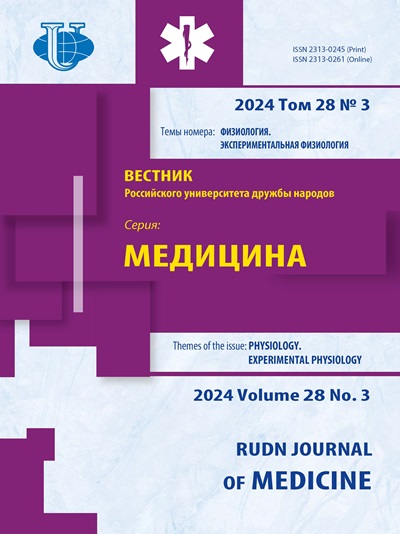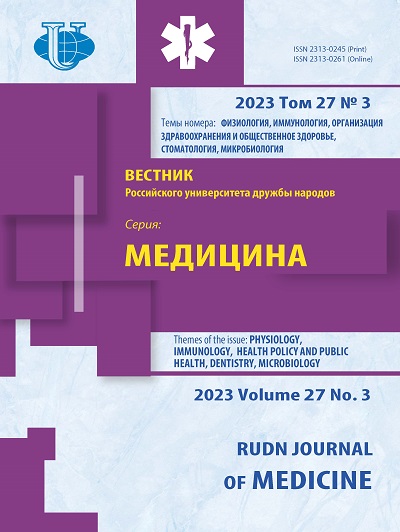Способы оценки потери слуха у младенцев
- Авторы: Сони Р.1, Какер С.1, Сабу Н.1
-
Учреждения:
- Колледж медицинских наук Раджастанского университета медицинских наук
- Выпуск: Том 27, № 3 (2023): ФИЗИОЛОГИЯ
- Страницы: 318-328
- Раздел: Физиология
- URL: https://journals.rudn.ru/medicine/article/view/36099
- DOI: https://doi.org/10.22363/2313-0245-2023-27-3-318-328
- EDN: https://elibrary.ru/QGIMBP
Цитировать
Полный текст
Аннотация
Актуальность. Способность слышать - одно из пяти основных чувств, позволяющих нам эффективно общаться с другими. К сожалению, люди часто воспринимают свой слух как нечто само собой разумеющееся и не осознают, насколько он важен, пока он не утрачен или не нарушен. Потеря слуха до недавнего времени не была главной проблемой индийского правительства. Профилактика, ранняя диагностика и уход могут предотвратить половину всех случаев глухоты и нарушений слуха. Слух имеет решающее значение для развития мозга ребенка. Раннее выявление потери слуха не позволит проблеме выйти из-под контроля. Наиболее экономически эффективной стратегией снижения бремени потери слуха является обследование новорожденных и младенцев. Потеря слуха является наиболее частым сенсорным дефицитом у людей во всем мире. Тяжесть потери слуха может варьироваться от легкой до тяжелой. Капур Сет др. предположили, что с помощью скрининга заболевание выявляется раньше, чем в противном случае оно было бы диагностировано. Из-за острой необходимости предотвращения инфекционных причин смертности новорожденные в Индии не проверяются регулярно на наличие каких-либо конкретных заболеваний. Отдел профилактики коммуникативных расстройств Всеиндийского института речи и слуха (AIISH), расположенный на юге Индии, регулярно проводит скрининг младенцев на нарушение слуха в различных больницах, связанных с ним, с использованием поведенческой обсервационной аудиометрии и скрининга отоакустической эмиссии (ОАЭ) и ведение Регистра высокого риска (HRR). В 2009-2010 годах в общей сложности 12 416 новорожденных в 10 больницах, связанных с AIISH, были обследованы на предмет нарушений слуха. В обзоре проанализированы различные вопросы, связанные с проверкой слуха младенцев в Индии. Методология исследования заключалась в поиске соответствующих статей в PubMed Central и Google Scholar по ключевым словам «слух, скрининг, потеря слуха и младенцы». Полнотекстовые статьи были загружены с июля 2022 г. по 19 сентября 2022 г. Релевантность оценивалась по статьям, описывающим теории скрининга слуха младенцев в Индии. Вывод. Проверка слуха у новорожденных имеет решающее значение для выявления врожденной тугоухости и обеспечения раннего лечения. Каждый человек имеет право на здоровый образ жизни. Нарушение слуха, как и расстройства общения, начинается в раннем возрасте. Младенцы с потерей слуха смогут полностью реализовать свой потенциал как полноценные, активные и интегрированные члены общества только в том случае, если будут реализованы систематические программы раннего скрининга. Скрининг слуха новорожденных имеет решающее значение для выявления врожденной тугоухости. AABR считается необходимым для HRNHS у новорожденных с высоким риском (недоношенность, аноксия, гипербилирубинемия), которые подвержены риску слуховой нейропатии, которую невозможно обнаружить с помощью теста ОАЭ. Тест ОАЭ проводится быстрее и проще, но у него более высокий уровень ложноположительных результатов, чем у AABR. Идеальная процедура проверки слуха еще находится в стадии разработки. В результате методика проверки слуха должна быть адаптирована к конкретным требованиям каждого центра.
Ключевые слова
Об авторах
Р. Сони
Колледж медицинских наук Раджастанского университета медицинских наук
Автор, ответственный за переписку.
Email: drrajeevsoni5@gmail.com
ORCID iD: 0000-0002-3511-7087
г. Джайпур, Раджастан, Индия
С. Какер
Колледж медицинских наук Раджастанского университета медицинских наук
Email: drrajeevsoni5@gmail.com
ORCID iD: 0000-0001-8947-2036
г. Джайпур, Раджастан, Индия
Н. Сабу
Колледж медицинских наук Раджастанского университета медицинских наук
Email: drrajeevsoni5@gmail.com
ORCID iD: 0000-0002-3874-1459
г. Джайпур, Раджастан, Индия
Список литературы
- Humes LE. The World Health Organization’s hearing-impairment grading system: an evaluation for unaided communication in age-related hearing loss. Int J Audiol. 2019;58(1):12-20. doi: 10.1080/14992027.2018.
- WHO Global Estimates on Prevalence of Hearing Loss. Mortality and Burden of Diseases and Prevention of Blindness and Deafness WHO; 2012. Available from: http://www.who.int/pbd/deafness/WHO_GE_HL.pdf. [Last accessed on 2022 October 02].
- Mathers C, Smith A, Concha M. Global burden of hearing loss in the year 2000; 18(4): 1-30. https://www.who.int/healthinfo/statistics/bod_hearingloss.pdf
- State of Hearing and Ear Care in the South East Asia Region. WHO Regional Office for South East Asia. World Health Organization. Available from: http:// www.searo.who.int/LinkFiles/Publications_HEARING_&_EAR_CARE.pdf. [Last accessed on 2022 October 09].
- Garg S, Chadha S, Malhotra S, Agarwal AK. Deafness: burden, prevention and control in India. Natl Med J India. 2009;22(2):79-81.
- Report No. 485: Disabled Persons in India, JulyDecember 2002. NSS 58th Round. National Sample Survey Organisation. Ministry of Statistics and Programme Implementation. Government of India. December, 2003. [Last accessed on 2022 October 09].
- Directorate General of Health Services. National Programme for Prevention and Control of Deafness, Project Proposal. New Delhi: Ministry of Health and Family Welfare; 2006 [Last accessed on 2022 October 09].
- Kapoor S, Kabra M. Newborn screening in India: current perspectives. Indian Pediatr. 2010;47(3):219-224. doi: 10.1007/s13312-010-0043-0
- Nagapoornima P, Ramesh A; Srilakshmi, et al. Universal hearing screening. Indian J Pediatr. 2007;74(6):545-549. doi: 10.1007/s12098-007-0105-z
- Cunningham M, Cox EO. Committee on Practice and Ambulatory Medicine and the Section on Otolaryngology and Bronchoesophagology. Hearing assessment in infants and children: recommendations beyond neonatal screening. Pediatrics. 2003;111(2):436-440. doi: 10.1542/peds.111.2.436
- Mukherjee SS, Mukherjee S, Sarkar KD. Prevalence of Hearing Loss in High Risk Infants of Mediocre Socio-economic Background at Around One Year of Age and Their Correlation with Risk Factors. Indian J Otolaryngol Head Neck Surg. 2013;65(Suppl 3):598-603. doi: 10.1007/s12070-012-0580-z
- Annual Report 200910. All India Institute of Speech and Hearing. 2009;10. [Last accessed on 2022 October 09].
- American Academy of Pediatrics, Joint Committee on Infant Hearing. Year 2007 position statement: Principles and guidelines for early hearing detection and intervention programs. Pediatrics. 2007;120(4):898-921. doi: 10.1542/peds.2007-2333.
- Ewing IR, Ewing AWG. The Ascertainment of Deafness in Infancy and Early Childhood. The Journal of Laryngology & Otology. 1944;59(9):309-333. doi: 10.1017/S0022215100007465.
- Froeschels E, Beebe H. Testing the hearing of new-born infants. Archives of otolaryngology. 1946;446:710-4.
- Hardy BJ, Dougherty A, Hardy WG. Hearing responses and audiologic screening in infants. The Journal of Paediatrics. 1959;55(3):382-390. https://doi.org/10.1016/S0022-3476(59)80233-X.
- Simmons FB, Russ FN. Automated New-born Hearing Screening, the Crib-o-gram. Arch Otolaryngol. 1974;100(1):1-7. doi: 10.1001/archotol.1974.00780040005001.
- Bennett MJ. Trials with the auditory response cradle. 1-Neonatal responses to auditory stimuli. Br J Audiol. 1979;13(4):125-134. doi: 10.3109/03005367909078887.
- Bennett MJ. Trials with the auditory response cradle III: head turns and startles as auditory responses in the neonate. Br J Audiol. 1980;14(4):122-131. doi: 10.3109/03005368009072017.
- Bennett MJ, Lawrence RJ. Trials with the Auditory Response Cradle. II - The neonatal respiratory response to an auditory stimulus. British Journal of Audiology. 1980 Feb;14(1): 1-6.doi: 10.3109/03005368009078892.
- Rai N, Thakur N. Universal screening of newborns to detect hearing impairment-is it necessary? Int J Pediatr Otorhinolaryngol. 2013;77(6):1036-1041. doi: 10.1016/j.ijporl.2013.04.006.
- American Academy of Pediatrics, Joint Committee on Infant Hearing. Year 2007 position statement: Principles and guidelines for early hearing detection and intervention programs. Pediatrics. 2007;120(4):898-921. doi: 10.1542/peds.2007-2333.
- Lewis DR, Marone SA, Mendes BC, Cruz OL, Nóbrega Md. Multiprofessional committee on auditory health: COMUSA. Braz J Otorhinolaryngol. 2010;76(1):121-128. doi: 10.1590/S1808-86942010000100020.
- Sohmer H, Feinmesser M. Cochlear action potentials recorded from the external ear in man. Ann Otol Rhinol Laryngol. 1967;76(2):427-435. doi: 10.1177/000348946707600211.
- Jewett DL, Williston JS. Auditory-evoked far fields averaged from the scalp of humans. Brain. 1971;94(4):681-696. doi: 10.1093/brain/94.4.681.
- Schulman-Galambos C, Galambos R. Brain stem evoked response audiometry in newborn hearing screening. Arch Otolaryngol. 1979;105(2):86-90. doi: 10.1001/archotol.1979.00790140032006.
- Herrmann BS, Thornton AR, Joseph JM. Automated infant hearing screening using the ABR: development and validation. American Journal of Audiolgy1995; 4:6-14.doi: 10.1044/1059-0889.0402.06.
- Sininger YS. Auditory brain stem response for objective measures of hearing. Ear Hear. 1993;14(1):23-30. doi: 10.1097/00003446-199302000-00004.
- Joint Committee on Infant Hearing; American Academy of Audiology; American Academy of Pediatrics; American Speech-Language-Hearing Association; Directors of Speech and Hearing Programs in State Health and Welfare Agencies. Year 2000 position statement: principles and guidelines for early hearing detection and intervention programs. Joint Committee on Infant Hearing, American Academy of Audiology, American Academy of Pediatrics, American Speech-Language-Hearing Association, and Directors of Speech and Hearing Programs in State Health and Welfare Agencies. Pediatrics. 2000;106(4):798-817. doi: 10.1542/peds.106.4.798.
- Bakhos D, Marx M, Villeneuve A, Lescanne E, Kim S, Robier A. Electrophysiological exploration of hearing. Eur Ann Otorhinolaryngol Head Neck Dis. 2017;134(5):325-331. doi: 10.1016/j.anorl.2017.02.011.
- Gorga MP, Preissler K, Simmons J, Walker L, Hoover B. Some issues relevant to establishing a universal newborn hearing screening program. Journal of American Academy of Audiol. 2001;12(2):101-112.
- Vohr BR, Oh W, Stewart EJ, Bentkover JD, Gabbard S, Lemons J, Papile LA, Pye R. Comparison of costs and referral rates of 3 universal newborn hearing screening protocols. Journal of Pediatr. 2001;139(2):238-244. doi: 10.1067/mpd.2001.115971.
- Cone-Wesson B, Vohr BR, Sininger YS, et al. Identification of neonatal hearing impairment: infants with hearing loss. Ear Hear. 2000;21(5):488-507. doi: 10.1097/00003446-200010000-00012.
- Gorga MP, Worthington DW, Reiland JK, Beauchaine KA, Goldgar DE. Some comparisons between auditory brain stem response thresholds, latencies, and the pure-tone audiogram. Ear Hear. 1985;6(2):105-112. doi: 10.1097/00003446-198503000-00008.
- Kileny PR, Magathan MG. Predictive value of ABR in infants and children with moderate to profound hearing impairment. Ear Hear. 1987;8(4):217-221. doi: 10.1097/00003446-198708000-00005.
- Johnsen NJ, Bagi P, Elberling C. Evoked acoustic emissions from the human ear. III. Findings in neonates. Scand Audiol. 1983;12(1):17-24. doi: 10.3109/01050398309076220.
- Bray P, Kemp D. An advanced cochlear echo technique suitable for infant screening. Br J Audiol. 1987;21(3):191-204. doi: 10.3109/03005368709076405.
- Bonfils P, Dumont A, Marie P, Francois M, Narcy P. Evoked otoacoustic emissions in newborn hearing screening. Laryngoscope. 1990;100(2 Pt 1):186-189. doi: 10.1288/00005537-199002000-00015.
- Lafreniere D, Jung MD, Smurzynski J, Leonard G, Kim DO, Sasek J. Distortion-product and click-evoked otoacoustic emissions in healthy newborns. Arch Otolaryngol Head Neck Surg. 1991;117(12):1382-1389. doi: 10.1001/archotol.1991.01870240074012.
- Prieve BA, Fitzgerald TS, Schulte LE. Basic characteristics of click-evoked otoacoustic emissions in infants and children. J Acoust Soc Am. 1997;102(5 Pt 1):2860-2870. doi: 10.1121/1.420341.
- Kok MR, van Zanten GA, Brocaar MP. Growth of evoked otoacoustic emissions during the first days postpartum. A preliminary report. Audiology: Official Organ of the International Society of Audiology. 1992;31(3):140-149. doi: 10.3109/00206099209072909
- Vohr BR, Letourneau KS, McDermott C. Maternal worry about neonatal hearing screening. J Perinatol. 2001;21(1):15-20. doi: 10.1038/sj.jp.7200475
- Sininger, Yvonne S. Identification of Auditory Neuropathy in Infants and Children. Seminars in Hearing 2002; 23: 193-200. doi: 10.1055/s-2002-34456.
- Ngui LX, Tang IP, Prepageran N, Lai ZW. Comparison of distortion product otoacoustic emission (DPOAE) and automated auditory brainstem response (AABR) for neonatal hearing screening in a hospital with high delivery rate. Int J Paediatric Otorhinolaryngology. 2019;120:184-188. doi: 10.1016/j.ijporl.2019.02.045.
- Vohr BR, Carty LM, Moore PE, Letourneau K. The Rhode Island Hearing Assessment Program: experience with statewide hearing screening (1993-1996). J Pediatr. 1998;133(3):353-357. doi: 10.1016/s0022-3476(98)70268-9.
- Apostolopoulos NK, Psarommatis IM, Tsakanikos MD, Dellagrammatikas HD, Douniadakis DE. Otoacoustic emission-based hearing screening of a Greek NICU population. Int J Pediatr Otorhinolaryngol. 1999;47(1):41-48. doi: 10.1016/s0165-5876(98)00168-2.
- Jacobson JT, Jacobson CA, Spahr RC. Automated and conventional ABR screening techniques in high-risk infants. Journal of American Academy Audiol. 1990;1(4):187-195.
- Hermmann BS, Thornton AR, Joseph JM. Automated infant hearing screening using the ABR: development and validation, American Journal of Audiolgy.1995;4:6-14. doi: 10.1044/1059-0889.0402.06.
- Rapin I, Gravel J. «Auditory neuropathy»: physiologic and pathologic evidence calls for more diagnostic specificity. International Journal of Paediatric Otorhinolaryngology. 2003;67(7):707-728. doi: 10.1016/s0165-5876(03)00103-4.
- Benito-Orejas JI, Ramírez B, Morais D, Almaraz A, Fernández-Calvo JL. Comparison of two-step transient evoked otoacoustic emissions (TEOAE) and automated auditory brainstem response (AABR) for universal new-born hearing screening programs. Int. Journal of Paediatric Otorhinolaryngology. 2008;72(8):1193-1201. doi: 10.1016/j.ijporl.2008.04.011.
- Kepekci A. Evaluation of 1808 New-borns Hearing Screening Outcome. EJMO. 2018; 2(3): 135-137. doi: 10.14744/ejmo.2018.58076.
- Akinpelu OV, Peleva E, Funnell WR, Daniel SJ. Otoacoustic emissions in new-born hearing screening: a systematic review of the effects of different protocols on test outcomes. International journal of Paediatric Otorhinolaryngology. 2014;78(5):711-717. doi: 10.1016/j.ijporl.2014.01.021.
Дополнительные файлы


















